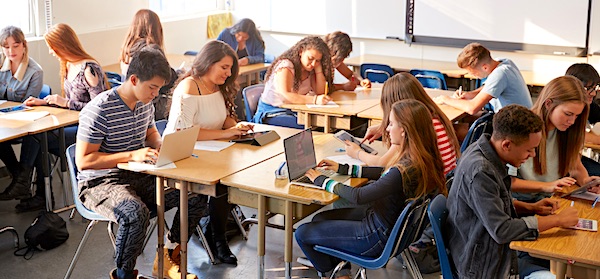 By Cathy Gassenheimer
By Cathy Gassenheimer
Executive Vice President
Alabama Best Practices Center
Occasionally, my colleague Stoney Beavers or I are asked to share strategies about how to effectively manage small group learning at the middle or high school level. As we know, John Hattie found small groups to be an effective strategy in his research and others interested in effective practices have explored small-group nuances.
A recent short article for Edutopia details a specific small group strategy used by a high school teacher and coach. This strategy for giving secondary students explicit feedback on group interactions promotes participation and collaboration, says Cheyanne Freitas, a high school math teacher and department chair in Dixon CA, a farming community west of Sacramento.
 As Freitas explains in helpful detail, her approach to small group learning is highly flexible and will work in just about any subject area.
As Freitas explains in helpful detail, her approach to small group learning is highly flexible and will work in just about any subject area.
Teachers take public notes and share them in a visible digital space while students work in groups. “This strategy works for assessments, labs, literature circles, and study groups,” she writes. “You can use this strategy for large or small tasks and remind students of these expectations whenever they work in groups.”
Here are some key elements of the article, followed by a link to her complete Edutopia post.
The Group Feedback Strategy
“Collaborative learning allows students to solve problems, construct explanations, critique other students’ reasoning, and engage in rich academic discourse. But as teachers, we all know how difficult it is to get students to communicate and collaborate.
“The group feedback strategy can help students learn effective group-level behaviors and understand the interactions you expect. It promotes student participation, collaboration, and equity.” – Cheyanne Freitas
► Preplanning
Before starting a task, make sure that students understand your expectations. Give them a list of expected group norms ahead of time. You may want students to (1) ask and answer clarifying questions, (2) share ideas with team members, (3) justify reasoning, and (4) critique and question the reasoning behind team members’ perspectives.
During team tests, for example, I want to see students explaining ideas and strategies to one another, leaning in and looking at each other’s work, asking questions, respectfully disagreeing with teammates, and working on the same problems at the same time so that various suggestions and strategies can be shared and discussed.
► Implementation
During implementation, display your student feedback to drive student actions. This way, students understand the implications of their actions and words as they work.
Feedback can take many forms. Typing on a document table while projecting it, typing on a designated slide or in the speaker notes section while students collaborate on a virtual assignment, or writing feedback on posters around the room are just a few suggestions.
Use color coding, plus or minus signs, and a dynamic grade to help students distinguish between positive and negative feedback. Consider the group’s work and their discussions. Highlight the positive interactions you witness and explain why they are positive as well as who was involved.
Keep negative remarks to a minimum to highlight and reinforce positive actions. I like to include neutral comments for random things I hear or notice; it’s a fun way to connect with students while also letting them know you’re paying attention. Keep a list of sentence frames or sample feedback handy if you worry about running out of comments.
► Debriefing and Grading
 Share your feedback with the entire class. Allow them time to read through each group’s comments. I also recommend holding a class debriefing discussion the first few times you use this strategy to acclimate the students. During this 5-minute discussion, I usually highlight a positive team point or ask students to share one they will try next time.
Share your feedback with the entire class. Allow them time to read through each group’s comments. I also recommend holding a class debriefing discussion the first few times you use this strategy to acclimate the students. During this 5-minute discussion, I usually highlight a positive team point or ask students to share one they will try next time.
Some teachers prefer to give grades, while others prefer to give feedback. I think it’s important for teachers to hold students accountable for their collaboration, and I’ve had more success when group feedback is graded.
Learn more about Cheyanne’s grading system and other ideas she has about grading, managing feedback, and smooth facilitation by reading the complete article at Edutopia:
A Step-by-Step Guide to Teaching Students to Work in Groups
FOR MORE IDEAS:
►A middle school small groups resource:
Get Students Working Effectively in Groups (Barbara Blackburn)
►An elementary small groups literacy resource:
Making the Most of Small Groups with Jennifer Serravallo (Podcast + Transcript)
►A good general resource:
Small Groups: Broadening Our Perspective (the #G2Great Literacy Lenses blog)


0 Comments on "A Strategy for Teaching Students to Work Effectively in Groups"